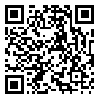BibTeX | RIS | EndNote | Medlars | ProCite | Reference Manager | RefWorks
Send citation to:
URL: http://rehabilitationj.uswr.ac.ir/article-1-410-en.html
2- Shari'ati Hospital, Isfahan, shariati haspital
3- Isfahan University of Medical Science, Rehabilitation Faculty, school of rehabilitation in Isfahan university
4- Isfahan University of Medical Science, Public Health Faculty, school of health in Isfahan university
Objective: Synkiesia is a sequel of facial nerve palsy. It usually begins 3-4 months after axonal regeneration and progressed up to two years afterward. Treatment of synkinesia is very difficult and sometimes impossible.The aim of our study is find a better procedure to treat facial nerve palsy and prevent synkinesia.
Materials and Methods: Twenty nine patients with facial nerve palsy were selected by electrodiagnosis tests. They were divided in two groups. The experimental group was treated by biofeedback electromyography and the second group was treated by common physiotherapy. The evaluation of all patients was done by Photoshop assessment and facial grading scale before and after treatment.
Result: After the treatment, a significant general improvement was observed in both groups (p<0.05), but in experimental group (biofeedback) showed better result than the other one. The number of patients with synkinesia as well as the severity of their synkinesis in experimental group were lesser than the other one.
Conclusion: Biofeedback therapy is more efficient than common physiotherapy.By using this approach, control and reducing synkinesia is more feasible. Assessment by Pohotoshop procedure showed better accuracy than facial grading scale.
Received: 21/02/2010 | Accepted: 29/12/2013 | Published: 29/12/2013
| Rights and permissions | |
 |
This work is licensed under a Creative Commons Attribution-NonCommercial 4.0 International License. |





